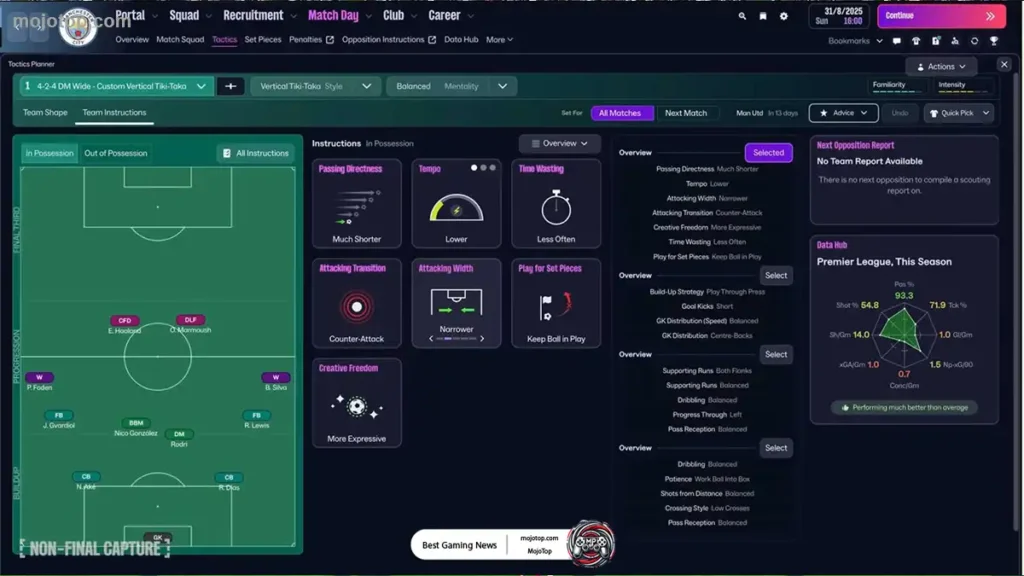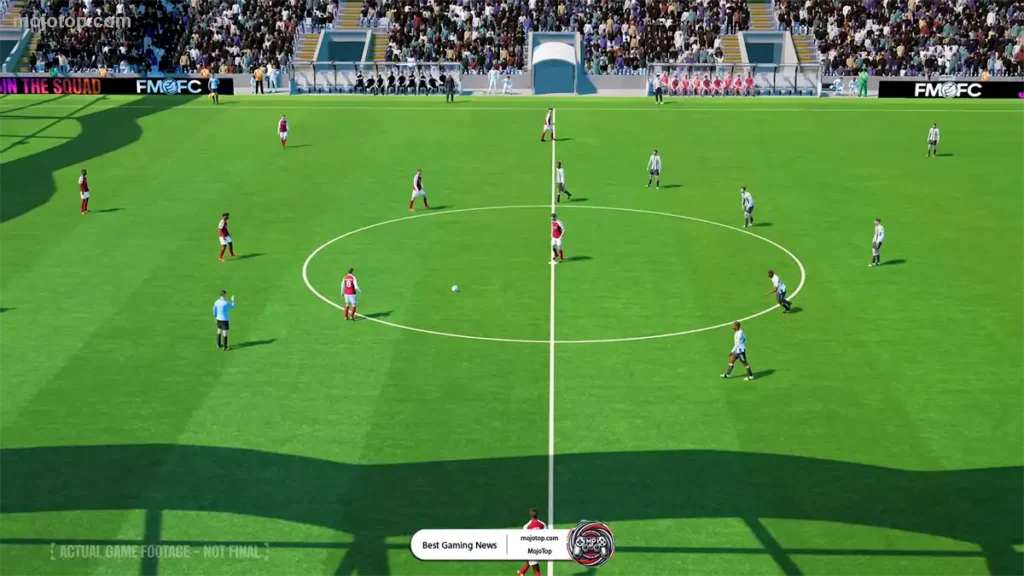Football Manager 2026: 3 Exciting New Features Revealed
Discover the biggest gameplay changes and upgrades coming with Football Manager 2026 features that redefine your management experience.
A Bold New Era in Football Simulation
When Football Manager 26 finally returns on 4 November 2025, it does so with more ambition and innovation than ever.The cancellation of the previous edition gave developers extra time to rebuild from the ground up — and that shows in the depth and polish of the confirmed Football Manager 2026 features.
In this introduction, we’ll explore how Football Manager 26 reinvents the franchise, integrating modern design, tactical evolution, and expanded content to deliver a more immersive and flexible management experience.
If you enjoy management simulators like Football Manager 26, you might also want to explore our full list of the best PC games that deliver deep strategy and realistic gameplay experiences.
From Cancellation to Reinvention
The decision to cancel the 2025 edition was controversial but ultimately allowed Sports Interactive to refocus their direction. Rather than settle for an incremental update, the team committed to rebuilding core systems — especially in terms of visuals, tactical control, and club management mechanics.
This extra development time enabled the introduction of several headline Football Manager 2026 features that might not have been possible under a tighter annual cycle.
A New Engine and Visual Leap
One of the most consequential changes in Football Manager 26 is the shift to the Unity engine. This transition supports enhanced matchday graphics, smoother animations, more lifelike player movement and ball physics, and richer stadium environments.
Across platforms — from PC to consoles and mobile — the engine upgrade lays the foundation for consistent visual fidelity and better scalability. The revamped user interface further complements this, with a redesigned layout, improved navigation, and the integration of a “Portal” hub for key game functions.
Tactical Revolution: In-Possession & Out-of-Possession
Perhaps the signature Football Manager 2026 features is the introduction of dual formations — separate systems for when your team has possession (attacking) and when it’s defending (out of possession). This adds a new layer of realism and strategic depth: your squad can shift roles fluidly depending on which phase of play they are in.
Team Instructions have also been overhauled for clarity and visual feedback. Changes in tactic sliders, width, tempo, and pressing now reflect live adjustments via a visualiser — you’ll see exactly how your instructions affect player positions and movement.
New role naming and structure support this system. Legacy role names like “Mezzala” and “Trequartista” are removed, replaced with clearer, phase-aware roles. This evolution gives players more tactical control without being bound by outdated constraints.
Expanded Club Management & Realism
Beyond matchday, Football Manager 26 enriches your role as a manager with deeper recruitment, squad building, and youth development systems — all part of the suite of Football Manager 2026 features. The TransferRoom-powered recruitment tools now provide better insights into how a player fits your tactics. AI clubs’ transfer logic is more sophisticated, with improved loan negotiation logic, recall rules, and financial fair play effects.
Moreover, save game compatibility has been extended: you can carry over saves from FM23 and FM24 into Football Manager 26, retaining continuity in your long-term projects.
The Promise of a Unified Football Ecosystem
Football Manager 26 also integrates women’s football fully into the game universe — not as an add-on, but as a core element of the football environment. Over 36,000 female players across multiple leagues are included, with distinct trait systems and economics tailored to realism.
The hope is that the combined improvements in engine, tactics, recruitment, and content will make Football Manager 26 not just a sequel, but a new baseline. The Football Manager 2026 features are designed to set a higher bar — evolving the series rather than iterating on it.

Smarter AI and Tactical Depth in Football Manager 26
In Football Manager 26, one of the most transformative advances lies in the enhanced AI logic and the deeper tactical systems introduced via the new Football Manager 2026 features. Together, they push the boundaries of what realistic management simulation can deliver — making matches more unpredictable, strategies more meaningful, and your managerial decisions more critical.
Dual Formations: In Possession vs. Out of Possession
A headline tactical innovation among the Football Manager 2026 features is the ability to use separate formations depending on whether your team has the ball or is defending.
-
When you take the ball, the In Possession formation defines how your players structure themselves offensively — dictating spacing, overlaps, passing lanes, and roles to support possession play.
-
Conversely, the Out of Possession formation governs how your side defends — pressing, compactness, zones, and transition shapes.
-
A combined or “Both” view gives you the ability to see how these two shapes interact or overlap, making it easier to refine the transitions between attack and defense.
This dual-formation system provides significantly greater tactical flexibility than past versions, where a single formation and fixed duties often constrained how fluid play could become.
The Tactical Visualiser: Watch Your Strategies in Action
To complement the dual formations, one of the standout Football Manager 2026 features is the new Tactical Visualiser.
-
This tool breaks down the pitch into zones (defensive, middle, attacking thirds), allowing you to click on different areas and preview how your formation and instructions dynamically respond to ball movement.
-
It shows how roles shift during different phases of the play — for example, a wing-back might tuck in centrally during buildup, or midfielders might adjust their shape depending on opponent pressure.
-
The Visualiser also displays expected behavior — giving you predictive insight into how well your tactic might hold up before the match even begins.
This shift from guessing-based tactics to visually guided planning ensures your choices are more informed and precise.
Overhauled Role System & Fewer Hardcoded Instructions
In tandem with formation changes, Football Manager 2026 features include a major redesign of player roles and removal of the rigid “duty” system (Attack, Support, Defend).
-
Many legacy role names — such as Mezzala, Trequartista, Enganche — have been retired. The new role structure is more phase-aware: roles differ in how a player contributes when in possession vs. out of possession.
-
A fresh set of Out of Possession roles now defines how the same player can behave defensively — e.g. screening, pressing, shifting blocks — depending on attributes and familiarity.
-
Because the system is less tied to rigid role-to-instruction mapping, you gain more control over how individual players act — micro-managing how width, tempo, pressing, transitions, or line depth adjust in real time.
This freedom reduces guesswork and lets your strategy express itself more cleanly.
Smarter Match Engine & Adaptive AI Behavior
Under the hood, the match AI and engine mechanics have also been significantly refined as part of the Football Manager 2026 features — making the tactical depth more meaningful in live matches.
-
Pass risk assessment has been revamped: players now more intelligently judge danger when attempting passes, so line-breaking passes (through balls, threaded passes) feel sharper and less formulaic.
-
Dribbling and ball carrying have improved — attackers may bait defenders, vary pace, shift direction, or create space dynamically.
-
Defensive AI gets upgraded logic: better anticipating passes, stepping up or dropping off, adaptive pressing shapes, more instinctive interceptions and block adjustments.
-
Goalkeepers and their decision-making (crosses, distribution, reflexes) have also seen enhancements, reinforcing that no position is static under the new system.
All of these internal improvements aim to make AI opponents more challenging, less predictable, and more tactical — which pays off especially across long careers.

Why This Matters for Your Strategy
With smarter AI and deeper tactical systems, your role as a manager evolves:
-
You’ll need to think more about transitions rather than purely build-up or defensive structure.
-
Tactical nuance — knowing when to press, when to sit deep, when to exploit half-spaces — becomes more valuable.
-
Match previews and in-game tweaks are more meaningful because how your side will likely react is clearer.
-
Long-term consistency is rewarded: creating a philosophy that holds up across multiple fixture types (cup games, league, derbies) matters more.
If you’re ready to experience the new tactical depth and smarter AI firsthand, you can get Football Manager 26on Steam and start building your ultimate club today.
Enhanced Player Development System
One of the most anticipated evolutions in Football Manager 26 is the overhaul of its youth development and player progression mechanics, which stands out among the latest Football Manager 2026 features. In previous installments, player growth often followed predictable paths, limiting the challenge and surprise in long-term saves. In FM26, the development engine is reimagined to feel more organic, dynamic, and responsive — which means nurturing talents, rebuilding squads, and investing in prospects all feel more rewarding and unpredictable.
A More Realistic Growth Curve
Rather than rigid progress tied only to training schedules, the improved system in Football Manager 26 leans toward a variation-based development model. In practice, this means:
-
A young player’s growth trajectory can accelerate or stall depending on match time, form, morale, injuries, and the tactical fit with your team.
-
Breakout seasons become possible: a 19- or 20-year-old with few expectations might suddenly make a major leap if circumstances align (good coaching, confidence, consistent play).
-
Conversely, even high-potential players can hit plateaus if mismanaged — overtraining, lack of game minutes, or role mismatch may slow development.
These mechanics make the player development pathway feel less formulaic and more emergent, adding stakes to every decision about youth promotions, substitutions, and loan spells.
Coaching & Staff Influence Amplified
As part of the enhanced player development system, the coaching staff and backroom environment now play a stronger role:
-
Coaches have improved influence in growth curves: quality of coaching, compatibility of training philosophy, and specialization (e.g. technical, physical, mental) shape how quickly a player improves in specific attributes.
-
Mentor systems or “senior influence” (veteran players guiding younger teammates) are expected to be more tangible. This means that veteran presence in your squad or training groups can aid growth in attributes like composure, decision-making, and leadership.
-
The staff feedback loop is deeper: assistant and youth coaches give more nuanced recommendations (e.g. which attributes to focus on, whether to shift a player’s role) rather than generic “train more” directives. This supports more hands-on development decisions.
Together, these changes elevate staff recruitment and assignment — selecting the right coaches becomes as important as signing the right players.
Role Adaptation and Position Flexibility
Football Manager 2026 features include an expanded system for role adaptation, allowing players to gradually adjust to new positions or hybrid roles over time. In Football Manager 26:
-
Young players may be monitored for positional flexibility — e.g. converting a winger into an inside forward or full-back into wing-back — based on their attributes and tactical exposure.
-
Training focus can prioritize transitional attributes (e.g. a full-back working on crossing, stamina, or defensive positioning) to facilitate role conversions.
-
Compatibility and familiarity with multiple roles is now more meaningful: players trained in varied roles might recover better if needed, boosting squad depth and tactical flexibility.
This allows for more creative squad building and career planning: you may spot a hidden full-back candidate among midfielders, or retool a player’s trajectory in line with your tactical vision.
Loan & Reserve Pathways Reinvented
Long-term saves often depend on loan systems and reserve teams. The enhanced player development system in FM26 is expected to refine these pathways:
-
Loan simulations are deeper: how much a player plays at the loan club, compatibility with the loan club’s tactics, and relationships with coaching staff will affect growth gains.
-
Recall and mid-loan adjustments become more important — if a loan club isn’t providing enough minutes or is using a mismatched system, you’ll be able to intervene more meaningfully.
-
Reserve and U23 teams act as intermediate stepping stones: giving minutes in reserve matches or U23 competitions can keep growth steady for fringe youngsters rather than forcing them straight into senior matches.
These tweaks help mitigate “stuck in the reserves” frustrations common in earlier games and ensure the development journey for prospects is smoother and more realistic.
Performance Feedback & Growth Transparency
Another core aspect of the new development system is greater transparency and feedback:
-
Growth reports and coaching feedback are more detailed: you’ll receive insight into which attributes improved, lagged, or even regressed, and what training/in-game factors influenced those changes.
-
Player comparisons are enhanced: you can compare a prospect’s development curve to historical benchmarks or peers, giving you a sense of whether they’re outperforming or underachieving.
-
Warnings or red flags: the system may flag players whose development seems stalled or regressing, prompting you to change training regimes or loan plans.
These improvements help reduce guesswork and make talent management more strategic.
Strategic Implications for Your Club
With these enhancements to youth and player growth, Football Manager 26 shifts how you build your club:
-
Long-term planning matters more: your success will often hinge on developing players internally rather than relying purely on transfers.
-
Staff recruitment is as strategic as scouting: hiring coaches who align with your philosophy and can nurture talent becomes crucial.
-
Player pathways need careful design: choosing when to promote, loan, or retrain youth will shape whether they become starters or busts.
-
Flexibility breeds resilience: players trained in varied roles reduce vulnerability from injuries or tactical shifts.
Revamped Matchday Experience
One of the most exciting aspects of Football Manager 26 is its comprehensive revamp of matchday presentation and immersion, making Football Manager 2026 features shine in every moment on the pitch. The matchday experience is no longer just a simulation of tactics and outcomes — it’s become a cinematic, atmospheric, and deeply responsive environment that pulls you into the drama of every fixture.
Richer On-Pitch Visuals and Atmosphere
At first glance, the visual enhancements in Football Manager 26 stand out among the top Football Manager 2026 features. The lighting system has been overhauled — dynamic skies, time-of-day adjustments, and improved contrast give each match a sense of realism. Stadiums and surroundings are more detailed, and the pitch surface reacts to weather conditions with visible wetness, rain effects, shadows, and nuanced texture changes.
These upgrades mean that whether you’re managing in a top-tier arena or in a smaller stadium, the environment feels appropriate and grounded in context. The level of polish creates a stronger sense of place and stakes for each match.
New Animations, Movement, and Player Personality
Under the hood, hundreds of new player animations have been added in FM26 to reflect more authentic movement, dribbles, passing motion, shooting, and off-the-ball behavior. These animations combine motion-capture data and context blending, making transitions between actions feel smoother and more natural.
Attackers may now hesitate, shift direction, or bait defenders before committing to a move. Defenders respond more intelligently to running lines and pressure. Even goalkeepers benefit — their actions, reflexes, dives, and positioning feel more lifelike. Together, these movement upgrades deepen immersion and make what you see on screen better reflect what you might expect in real matches.
Dynamic Highlight Mode & Smarter Camera Work
One of the most user-facing additions under the matchday suite of Football Manager 2026 features is Dynamic Highlight Mode. Rather than a fixed number of clips per match, the system adapts: tighter games generate more highlights, while more lopsided matches show fewer. This ensures the flow remains smooth but key moments are still flagged for attention.
The rebuilt camera system supports both a cinematic “Broadcast Mode” and adjustable tactical viewing angles. Replays now select camera angles based on the type of goal scored — a long-range strike might be shown with a wide-angle panorama, while tap-ins might get tighter closeups. The combination of adaptive camera work and cinematic framing helps the match feel less like a manager simulation and more like a televised football event.
Match Overview, Analytics & Dual Feedback
Between active play and highlights, Football Manager 26 introduces a refined Match Overview screen that merges classic 2D tactical views with live stats, assistant manager input, and context-sensitive data cards. This means you can glance at expected goals (xG), expected assists (xA), heat maps, passing networks, and more without needing to dig through menus.
Your backroom staff now give richer commentary, offering suggestions based on evolving match context — e.g., adjusting tempo, making substitutions, or shifting formation in response to fatigue or opponent threats. The combination of visual context and analytics helps make your decisions more informed and proactively reactive.
Enhanced Audio Design & Matchday Soundscape
A match doesn’t feel alive without sound. FM26 improves crowd ambience, audio layering, and transitional effects to match the drama. Roars swell after key moments; the tension builds during key attacks, and the soundtrack subtly supports climactic moments. The audio ambition in these Football Manager 2026 features helps amplify emotional highs and lows, making victories and defeats resonate more deeply.
Why the Revamped Matchday Experience Matters
-
It turns matches into events: every fixture feels distinct, dramatic, and immersive rather than mechanically similar.
-
The blend of visuals, sound, and analytics gives you an emotional and strategic connection to what happens on the pitch.
-
With smarter camera and highlight systems, you stay focused on the flow of the match, not menu juggling.
-
The presentation layer reinforces all other features — tactical depth, AI behavior, player development — by giving them a stage that feels real.
In short, the Revamped Matchday Experience is a flagship component of the Football Manager 2026 features set, making Football Manager 26 feel like a new benchmark for immersive football management simulation.

